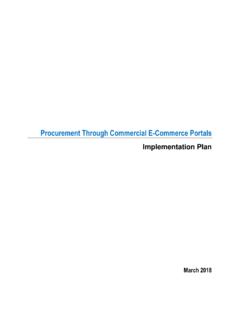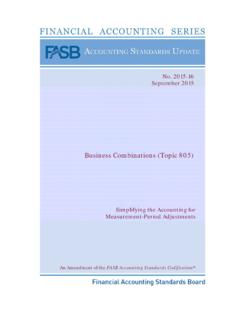Transcription of Risk, Issue, and Opportunity Management
1 Risk, Issue, and Opportunity Management Professor David Swinney Defense Acquisition University South Region April 25th, 2017 2 Risk and Risk Mitigation Defense AT&L: January February 2015 -Our task as managers involves optimization what are the highest-payoff risk-mitigation investments we can make with the resources available? -I expect our managers to demonstrate that they have analyzed this problem and made good judgments about how best to use the resources they have to mitigate the program s risk. 3 New Guide Risk, Issue, and Opportunity Management Guide for Defense Acquisition Programs: January 2017 4 Overview DoD Risk Management Guidance Risk Management Issue Management Opportunity Management DAU Risk Management Workshop 5 Risk, Issue, and Opportunity Relationship 6 Risk, issue, or Opportunity ? Risk, Issue, or Opportunity ? 7 Risk, issue, or Opportunity ? Risk, Issue, or Opportunity ?
2 8 Risk? Risk, Issue, or Opportunity ? 9 Small Opportunities If you don t actively attack the risks, they will actively attack you. Tom Gilb Principles of Software Engineering Management Bad news isn t wine. It doesn t improve with age. Colin Powell Opportunity is missed by most people because it is dressed in overalls and looks like work. Thomas Edison 10 Risk Management Overview 11 Risk Management Whose job? Program manager Chief engineer Integrated Product Team Leads Earned value managers Production planners Quality assurance Logisticians 12 Risk Management obstacles I know what I m If I don t then no one can blame me Going through the motions Issues vs. risks Who is in charge? 13 Risk and Issue Management Overview 14 Risk Definition Risk is the combination of the probability of an undesired event or condition and the consequences, impact, or severity of the undesired event, were it to occur.
3 The undesired event may be programmatic or technical, and either internal or external to the program. 15 Risk Planning Plans are planning is everything DDE 16 Framing assumptions and ground rules Framing Assumptions Consider and document assumptions Assumptions may introduce risks if they prove invalid Ground Rules Time frame - risk is evaluated as of today (not after planned mitigation, avoidance, etc.) Time of risk event - when risk hypothetically will occur WBS level dig to low levels to identify causal factors 17 Aligning Government and Contractor Risk Management Government, Prime Contractor and associated Subcontractors should employ consistent Risk Management processes Share Risk Management information Integrate Risk Management with: Requirements Development Design, Integration, and Test System Support and Sustainment Schedule Tracking Performance measurement Earned Value Management (EVM) Cost Estimating Issue Management ; Systems Engineering 18 Risk Identification 19 Identifying Risk: What Can Go Wrong?
4 Decorative Image Decorative Image I cannot imagine any conditions which would cause a ship to founder. I cannot conceive of any vital disaster happening to this vessel. Modern shipbuilding has gone beyond " Captain Smith, 1906, about the Adriatic (Captain of Titanic on the evening on 14 April, 1912) 20 Risk Identification All program personnel are encouraged to identify candidate risks. Cast your net wide at first! Do not ignore areas or eliminate ideas early in the process. 21 Approaches to Risk ID Product based evaluation Uses Work Breakdown Structure Looks at system architecture Identifies program relationships Process based evaluation Focuses on processes used to define, develop and test a system Looks at internal organizational processes Scenario based evaluation Risks from a customer and supplier point of view Requires knowledge of customers and suppliers, or their inputs/time C2 SystemCOPRedBlueNeutralC2 SystemCOPRedBlueNeutralPRODUCTFUNDINGDES IGNTESTPRODUCTIONFACILITIESLOGISTICSMANA GEMENTF unds PhasingPRODUCTFUNDINGDESIGNTESTPRODUCTIO NFACILITIESLOGISTICSMANAGEMENTF unds PhasingPrepareExecuteMissionRepairandMai ntainReceiveOrderDeployLocateTargetAttac kRecoverOrder Received, UnderstoodOrder Not ReceivedOrder Received.
5 Not UnderstoodTOP LEVELDECOMPOSITIONP repareExecuteMissionRepairandMaintainRec eiveOrderDeployLocateTargetAttackRecover Order Received, UnderstoodOrder Not ReceivedOrder Received, Not UnderstoodReceiveOrderDeployLocateTarget AttackRecoverOrder Received, UnderstoodOrder Not ReceivedOrder Received, Not UnderstoodTOP LEVELDECOMPOSITION22 Risk Analysis 23 Analyzing Risk: What Do Risks Mean? Estimate Likelihood/Consequence Technical Performance Schedule Cost Determine the Risk Level Use consistent predefined likelihood and consequence criteria Government and Contractor should use common framework Use Quantitative Data when possible 24 A Weak Risk Statement Makes an overly general observation: Weak: If the high vacancy rate in engineering staff persists, then the program staffing will be inadequate. Identifies an issue rather than a risk: Weak: Fatigue cracks discovered in already produced vehicles may shorten service life unless remedied.
6 Diverts focus from the program s controllable activities: Weak: If the program s funding is withheld due to poor test results, then the program schedule will be jeopardized. 25 Risk Statement Forms IF (some event) THEN (some consequence) WE MIGHT NOT (some promise) BECAUSE (some reason) THERE IS (some probability) THAT (some risk event) MAY OCCUR, RESULTING IN (some consequence) 26 Root Cause Determination We Might Not: Because: Meet Availability Requirements Why? Engine Does Not Start Why? Glow Plug Failed Why? Glow Plug Remains On After Start Why? Counterfeit Circuit Boards 27 Root Risk Event If Some negative event occurs Then Something bad may result Purchase Counterfeit Circuit Boards Root Risk Event Fail to Meet Availability Requirements Consequence 28 DoD Risk Reporting Matrix Tailored to program - Programs can break out cost or consolidate 29 Risk Analysis Risks are characterized as HIGH, MODERATE, or LOW based on rating thresholds.
7 These Risk Level estimates help programs manage risks and prioritize handling efforts. This difficult but important step in the risk Management process helps the program determine resource allocation and appropriate handling strategies. 30 Expected Monetary Value Programs should compare cost burdened risk and cost of handling strategies. Cost exposure of a risk can be expressed as its EMV, which is the likelihood of the risk multiplied by the cost consequence of the risk if realized. Cost of the risk handling effort is then subtracted from the risk exposure to determine the likely return on investment (ROI). 31 Risk Mitigation 32 Four Fundamental Strategies Avoid Eliminate the risk event or condition Control Act to reduce risk to an acceptable level Accept Accept the level of risk (but continue to track) Transfer Assign risk responsibility another entity 33 Risk Mitigation Approaches Multiple Development Efforts: Alternative Design Design of Experiments Mockups Technology Maturation Early Prototyping Process Proofing Robust Design Demonstration Events Models and Simulation Reviews, Walk-throughs, and Inspections 34 Risk Handling?
8 Why? Why? Why? Why? Mitigate? Certified Supplier Mitigate? More Spare Glow Plugs Mitigate? Start Engine in Warmed Shelter Mitigate? Circuit Redesign Mitigate? Change Availability Requirement Not My Problem Meet Availability Requirements Engine Does Not Start Counterfeit Circuit Boards Glow Plug Remains On After Start Glow Plug Failed 35 Risk Burn-Down RISK PILE Burn-down plan consists of 6 steps, tied to the project schedule, that allow the program to control and retire risks 1. Identify risk handling activities in a sequence 2. Define specific risk handling activities with objective, measurable outcomes 3. Assign a planned likelihood and consequence value to each risk handling activity 4. Estimate the start and finish dates for each risk handling activity 5. Put risk handling activities into the program schedule 6. Plot risk level versus time to show relative risk burn-down/reduction contribution of each activity 36 Mitigation Tracking Tool: Burn-down Chart Burn-down Chart Records the detailed steps planned for risk mitigation 37 Risk Monitoring 38 Risk Monitoring Answers the question: How have the risks changed?
9 A means to systematically track and evaluate risk handling plans against established metrics throughout the acquisition process Iterative and recursive - feeds info back thru risk handling, risk analysis, risk identification, and risk planning steps as warranted 39 Example Risk Monitoring and Trend Matrix 40 Risk Monitoring Expectations Regular status updates for any changes to likelihood or consequence Regular schedule for PMO/Contractor review of risks Alert Management when risk handling plans should be implemented or adjusted Alert the next level of Management when ability to handle a risk exceeds the lower level s authority or resources. Track actual versus planned implementation of progress Management indicator system over the entire program to monitor risk activity Review closed risks periodically to ensure their risk level has not changed 41 Issue Management 42 Issue Management 43 Issues vs Risks Risks are potential future events An issue is an event or situation with negative consequences that has already occurred or is certain to occur This distinction between an issue and a risk differentiates how they are managed.
10 44 Risks and Issues Risks are Future Problems: Focus is on Future Consequences Can be closed only after successful mitigation through controlling, avoiding, transferring, or accepting the risk Examples IF the sole source provider of a critical component goes out of business, THEN the program will be delayed by 6 months IF proprietary interfaces are used, THEN maintenance and support costs will likely increase as the program matures Issues are Current Problems: Focus is on Real-Time Consequences If the probability of occurrence is near certainty or if it has already occurred, it s an issue Examples Release of engineering drawings is behind schedule Test failure of components reveals a design shortfall 45 Issue Management Issue Management applies resources to address and reduce the potential negative consequences associated with a past, present, or certain future event.










